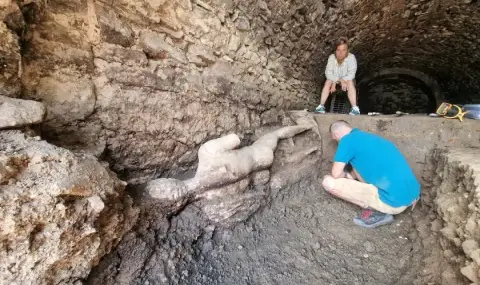Archaeologists came across an extraordinary find in the ancient city of Heraclea Sintika near Petrich, BNT reported.
The intact statue of the god came out during the excavations near Petrich. It is a completely preserved marble sculpture, created in the second century AD.
The figure is over two meters and probably depicts Hermes, the herald of the gods and protector of trade and merchants.
The cloaca maxima of the city, or the great canal of Heraclea Synthica, which collects all the sewage. That's why no one expected to find anything valuable there. They went in anyway to check if the structure had not given way after the recent downpours. One of the stones appeared to them to be marble, little by little the pedestal, the leg and the whole statue were revealed. They recognized the god Hermes in her. One of the most important deities for Herakleians.
"Hermes is very popular in Heraclea Synthica, we have bronze statuettes of him quite a lot, as well as relief inscriptions with images of Hermes. Something more. It remains popular even after Christianity takes hold," said Prof. Ludmil Vagalinski.
Over two meters, the statue of Hermes is carved from a single block of marble.
"This is a Heracleian trademark. It is very difficult! I always wonder why they do it to themselves and what masters they had. You make everything from a single block, because at that time the technique of assemblies from individual elements was already well known. It's easier to transport, you can sell it, you can fix it more easily. But these work hard from a block of marble. This is an old tradition of theirs" Prof. Ludmil Vagalinski added.
But a city that was a major commercial center certainly relied on the protection of Hermes, and his statue most likely stood in the most central place in the forum.
"In one of these large ones was the statue. They are all sanctuaries. In these niches below are pedestals. At the end of one of them we also found a Hermes tile. Votive Tile." explained Prof. Ludmil Vagalinski.
Paradoxically, if the disaster had not destroyed Heraclea Syntica, the statue of Hermes would not have been so well preserved, as well as the whole city.
Despite the great reverence for Hermes, he still ends up in the cloaca maxima, which is no place even for deposed gods.
Maria Cherneva - She has no place here!
Prof. Ludmil Vagalinski - She doesn't belong, Maria, they hid her. After an earthquake at the end of the 4th century, it was covered with earth. The infrastructure is not functioning
By the end of the fourth century, Christianity had already been imposed as the official religion by an edict of Emperor Theodosius. The earthquake that destroyed the city, however, came a few years later. Which means that the Heracleans did not give up their reverence for Hermes easily.
"They took a little risk! Yes, but not for very long, because the earthquake hit them a little after 388, and the edict was issued in 380. And I'm almost sure that until 388 he was still standing in the square", comments Prof. Ludmil Vagalinski.
It took a lot of effort to move Hermes to a safe place, they laid him carefully, probably the work of the priests who believed that they would appease the gods and their city would be saved.
